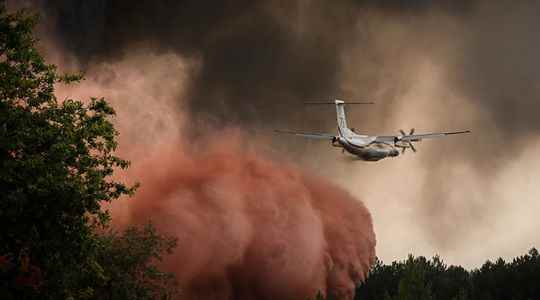Their name sounds straight out of a sci-fi movie. However, the phenomenon is very real: the “zombie fires” are partly responsible for the return of fires to Landiras, in the department of Gironde, already marked by the destruction of 14,000 hectares in mid-July. If the Minister of the Interior Gérald Darmanin designated the hand of possible arsonists, authorities and firefighters also underlined the accelerating role played by these underground fires. Also called peat fires, they are not really extinguished and remain in slow combustion in the earth, ready to reappear again.
The peat fires rekindle the fires that were thought to be extinguished. How to explain this phenomenon ? After consuming the trees, the fire burrows underground and the embers spread through the decaying roots. This fire, silent, can sink up to 50 centimeters and progress over a hundred meters. It is then enough that these embers encounter very favorable weather conditions, such as strong winds and an unprecedented drought, for them to blaze again on the surface.
Peat, or lignite, known in part of the soil of the forests in Gironde and Landes, is an organic matter, present in the subsoil. It is made up of plant debris and is very rich in carbon (about 20%), which explains its flammable nature. Usually very humid, it therefore becomes, once dry, an excellent fuel. These buried fires are also known in the Arctic boreal forests, where some fires – which occur in the spring – have been able to sleep all winter in the ground, even with the presence of snow. But climate change could make this phenomenon – so far rare – more frequent, according to a study published in the scientific journal Nature May 19, 2021.
- Does this mean that the Landiras fire was never extinguished in mid-July?
The fire, when it was very intense like last July, penetrated into the depths of the ground, where it remains in slow combustion. Thus, the new departures would have arisen outside the charred areas, on particularly dry areas due to the drought and previous fires. The Landiras fire had been fixed since July 29 but was “never declared extinguished”, indicated the prefecture: “he was buried” in this peat. “He was smoldering and only asked to leave,” assured Commander Matthieu Jomain, spokesperson for the firefighters, who are fighting against these fires which have destroyed more than 7,400 hectares since Tuesday August 9, in Gironde and in the Landes.
“When we dug the ground, we found temperatures of 150 degrees. We knew that in the peat, everything could come back”, added, Wednesday August 10 on BFM-TVBruno Lafon, mayor of Biganos (Gironde) and president of the Defense of forests against fire.
- How to fight against these fires, invisible to the naked eye?
Sometimes nestled a meter underground, these fires burn slowly in these peat soils and are difficult to detect. “It’s very vicious, it’s a flameless fire, like burning coal”, illustrates Anthony Collin, teacher-researcher at the University of Lorraine. In the Landes forest, the peat has become less visible and the embers are therefore better concealed. To overcome these walls of flames, firefighters must dig up to one meter deep before trying to extinguish the embers with pump buckets.
“When there are coniferous fires, as is the case in Gironde, the trees burn, fall and transmit the fire also under the lowest vegetation cover which will be closest to the ground. This fire will penetrate deep little by little in the peat, and will therefore be complicated to extinguish”, describes Stéphan Horn, lieutenant-colonel in the fire brigade and technical adviser for the Yvelines forest fires.
“It will last a very long time in Gironde, given the surface that has burned and the peat that is present,” he predicts. Rain is not expected until Sunday. “But it would take torrential rains for that to help us,” says Commander Jomain. According to the findings of a study published on July 13 in the scientific journal Natureforests are increasingly less able to bounce back and return to a stable state after a disturbance, such as drought or fire.
